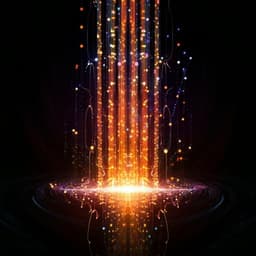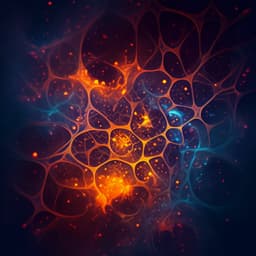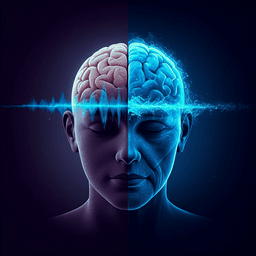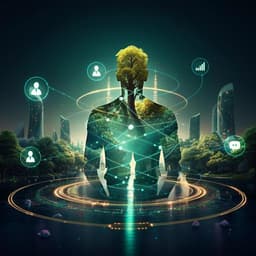
Medicine and Health
Behavioral and brain responses to verbal stimuli reveal transient periods of cognitive integration of the external world during sleep
B. Türker, E. M. Musat, et al.
Discover groundbreaking insights into sleep as not just a dormant state! This study by Başak Türker and colleagues reveals how individuals, including narcoleptics and healthy participants, exhibit behavioral responsiveness during sleep, suggesting possible real-time communication even in slumber.
~3 min • Beginner • English
Introduction
The study challenges the traditional view that sleep entails a complete behavioral disconnection from the environment. Prior work has shown preserved low-level sensory processing during sleep and even higher-level processing, but behavioral responsiveness during consolidated sleep remains debated, partly due to muscle atonia and the lack of single-trial behavioral evidence. This research asks whether sleepers can behaviorally respond to external verbal stimuli across sleep stages and whether such responsiveness reflects high-level cognitive processing. The authors hypothesize transient windows of increased cognitive integration during sleep that allow accurate, task-relevant responses, potentially more prevalent during lucid REM sleep. They aim to quantify behavioral responsiveness using facial electromyography (corrugator/zygomatic contractions) in a lexical decision task, assess accuracy and reaction times, and identify prestimulus EEG markers predicting responsiveness, thereby probing the neurophysiological basis of these transient windows.
Literature Review
Evidence from ERPs and intracranial recordings indicates sensory processing persists across sleep stages. Studies show sleepers can process symbolic stimuli at semantic and decisional levels, targeted memory reactivation can enhance later recall, and conditioning or implicit learning can occur during sleep, influencing subsequent behavior. Some studies report incorporation of external stimuli into dream content, suggesting occasional conscious processing. Behavioral responses have been observed during N1 (sleep onset), but deeper stages lack robust behavioral evidence, potentially due to limb muscle atonia masking responses. Facial muscles are less affected by atonia; eye-movement signals have enabled communication during lucid REM sleep. Prior work combining eye movements and facial contractions showed lucid dreamers can respond to queries during PSG-verified REM sleep. However, single-trial behavioral evidence beyond sleep onset and lucid dreams is scarce, motivating the present trial-by-trial behavioral and EEG analysis across sleep stages.
Methodology
Participants: 30 individuals with narcolepsy (NP; type 1 n=17, type 2 n=13) were recruited; 3 excluded due to technical issues, leaving n=27 (21 frequent lucid dreamers). Twenty-two healthy participants (HP; nonlucid dreamers) were recruited; 1 excluded, leaving n=21. All were native French speakers; ethics approved; medications paused for NP on test day; HP had sleep restriction prior to testing.
Design: Daytime nap paradigm. NP completed five 20-min naps in one day with ~80-min breaks; HP completed one 100-min nap mirroring the total duration. In each nap, 1-min ON stimulation periods alternated with 1-min OFF periods. During ON, participants heard verbal stimuli (French words and pseudowords; female voice; ~690 ms duration; 48 dB average, adjusted individually) presented every 9–11 s atop continuous white noise. Each nap's ON periods contained six stimuli per minute (3 words, 3 pseudowords), each stimulus presented only once in the entire experiment.
Task: Auditory lexical decision during which participants responded by three brief successive facial muscle contractions—frown (corrugator) versus smile (zygomatic)—depending on stimulus type. The mapping (word vs pseudoword) was counterbalanced. Participants were instructed to continue the task while awake or asleep, and to signal lucidity (if no stimulus was heard) with a mixed single corrugator then single zygomatic contraction.
Polysomnography and signals: Continuous EEG (10 channels: Fp1, Fp2, Cz, C3, C4, Pz, P3, P4, O1, O2; referenced to A2), EOG (2 channels), EMG (chin for staging; zygomatic and corrugator for behavior), and ECG at 2,048 Hz. Sleep stages (wake, N1, N2, N3, REM) were scored offline in 30-s epochs by a blind certified scorer per AASM rules; micro-arousals (3–15 s) were identified, and trials with micro-arousals were excluded. Corrugator/zygomatic channels were hidden during scoring. Naps were labeled lucid vs nonlucid from postnap reports; all REM epochs in lucid naps were labeled lucid REM.
Behavioral detection: Nap recordings were segmented into 10-s mini-epochs. A valid response required at least two consecutive contractions on corrugator or zygomatic EMG; single twitches were discarded. Scoring was blind to sleep stage and ON/OFF status; 10% rescored by a second rater (84% agreement). An automatic EMG-variance-based algorithm was also implemented for validation across parameter settings, replicating manual ON>OFF effects.
EEG preprocessing and analyses: Raw EEG re-referenced to A2, band-pass 0.1–45 Hz, notch 50/100 Hz, downsampled to 250 Hz. Epochs created for spectral (−1 to 8 s), ERP/TFR (−1 to 4 s), decoding (−350 to 1,700 ms), and marker computation (−1 to 0 s). Automatic artifact rejection (autoreject) applied using global thresholds per stage; two NP excluded from EEG analyses due to strict rejection.
Analytic approaches:
- Spectral PSDs (δ 1–4 Hz, α 8–12 Hz) computed for pre- and post-stimulus windows; normalized by total power and averaged across channels.
- Time-frequency analyses (Morlet wavelets 2–30 Hz; log-ratio baseline to −1–0 s) stimulus-locked and response-locked; mass-univariate mixed models across time per band and electrode; FDR corrected. Response-locked ERPs also computed.
- Prestimulus EEG markers (computed −1 to 0 s): normalized PSDs (δ, θ, α, β, γ), θ-band weighted symbolic mutual information (wSMI) connectivity, and complexity measures (Kolmogorov complexity, permutation entropy θ, sample entropy). Markers were z-scored per participant.
- Machine learning: Random forest (100 trees; class-weighted) trained per stage to classify responsive (R) vs nonresponsive (NR) trials using nine EEG markers plus participant ID. For NP: 10-fold stratified cross-validation; for HP: trained on NP N2, tested on HP N2. Balanced accuracy and F1 reported; chance estimated via 500 permutations. Analyses repeated for all responses, only correct, and only incorrect responses.
- Temporal generalization decoding: L2 logistic regression trained at each poststimulus time to distinguish stimulus-present vs dummy baseline trials over Cz, Pz, P3; fivefold CV; area under ROC (AUC) aggregated across folds and participants. Statistical significance via FDR-corrected sign tests.
Statistics: Mixed-effects models with participant as random intercept; binomial GLMMs for responsiveness (ON vs OFF), linear mixed models for RTs, Wilcoxon signed-rank for accuracy vs chance; FDR correction applied across test families. Postnap debriefing collected dream content, lucidity, perceived stimuli/responses, and memory (free recall and old-new recognition).
Key Findings
Behavioral responsiveness during sleep:
- Responses were significantly more frequent during ON vs OFF periods across multiple stages, excluding micro-arousals:
- Wake: HP 78.8% vs 1.5% (z=30.02, P<0.0001); NP 86.1% vs 2.1% (z=27.02, P<0.0001).
- N1: HP 22.2% vs 1.5% (z=10.99, P<0.0001); NP 64.2% vs 1.7% (z=18.29, P<0.0001).
- N2: HP 4.7% vs 1.9% (z=4.52, P<0.0001); NP 20.27% vs 2.2% (z=16.57, P<0.0001).
- REM (nonlucid): HP 6.5% vs 2.2% (z=3.59, P=0.0003); NP 34.2% vs 1.4% (z=13.93, P<0.0001).
- N3: HP not significant (0.2% vs 0.9%, z=−1.23, P=0.22); NP 5.7% vs 2.4% (z=3.31, P=0.0009).
- Response rates during ON decreased from wake to N1 to REM to N2; NP showed higher ON response rates than HP across all stages (all P<0.001), with similar OFF contraction rates across groups (χ²(1)=0.03, P=0.87).
Accuracy and reaction times:
- Task accuracy during responsive trials was above chance in all evaluable stages:
- HP: wake 94.2% (P<0.0001); N1 83.3% (P=0.0002); N2 84.5% (P=0.007).
- NP: wake 87.9% (P<0.0001); N1 84.1% (P<0.0001); N2 71.8% (P=0.002); nonlucid REM 73.37% (P=0.002).
- Accuracy decreased with deeper sleep (HP χ²(2)=11.01, P=0.004; NP χ²(4)=38.23, P<0.0001) and was higher in HP than NP (χ²(1)=13.65, P=0.0002).
- Pseudowords elicited slower correct responses than words across stages (HP χ²(1)=45.59, P<0.0001; NP χ²(1)=36.9, P<0.0001); mean slowing: ~100 ms (HP; median words 1.29 s) and ~130 ms (NP; median words 1.42 s).
- Accurate trials had shorter RTs than inaccurate ones in multiple stages (e.g., HP wake t=−6.91, P<0.0001; NP REM t=−5.275, P<0.0001).
Lucid REM sleep (NP only):
- Lucid naps reported in 33/134 (24.6%). In lucid REM, ON vs OFF response rates: 52.7% vs 6% (z=18.04, P<0.0001). Accuracy exceeded chance (65%, P=0.0008), similar to nonlucid REM (t=1.24, P=0.3).
- RTs were longest in lucid REM (median 2.1 s), significantly slower than N1 (1.56 s, P<0.0001), N2 (1.59 s, P=0.0001), and nonlucid REM (1.49 s, P=0.002), and wake. Lucidity increased REM response rate (z=7.97, P<0.0001). Task recall higher after lucid than nonlucid naps with responses (75.8% vs 15.5%; χ²(2)=36.15, P<0.0001).
EEG during responsive sleep trials:
- Prestimulus and poststimulus PSDs in responsive trials matched sleep-stage profiles (lower α, higher δ vs wake), supporting bona fide sleep.
- Stimulus-locked TFRs: responsive vs nonresponsive trials showed stronger/sustained frontal α (8–12 Hz) and β (12–30 Hz) increases ~1.2–3.8 s poststimulus; response-locked analyses showed α/β power increases starting ~700 ms before response, co-occurring with a frontal Bereitschaftspotential.
Prestimulus EEG markers and prediction:
- Across nonlucid trials (NP and HP), responsive vs nonresponsive trials in the −1 s prestimulus window exhibited higher complexity and higher high-frequency PSDs, and lower δ PSD; wSMI connectivity did not differ.
- Random forest classification of R vs NR using prestimulus markers: balanced accuracy >60% across NP stages (up to 67% in REM) and 58% in HP N2; all above permutation chance (P≤0.006). Restricting to correct responses improved performance (NP REM 72%; HP N2 61%; P=0.002). Using only incorrect responses reduced performance to chance in all but NP N1.
Conscious processing in lucid REM:
- In lucid REM, prestimulus markers did not differ between R and NR (Bayes factors favored null), consistent with a ceiling of high cognitive state. Lucid vs nonlucid REM showed higher complexity and γ PSD, and lower δ PSD in lucid trials.
- Temporal generalization decoding revealed a sustained square-like pattern starting ~350 ms poststimulus in lucid REM responsive trials, a neural signature associated with conscious access, alongside subjective reports of doing the task.
Discussion
The study demonstrates that sleeping humans can transiently connect to external stimuli and produce accurate, task-appropriate behavioral responses across multiple sleep stages (N1, N2, REM). These responsive windows are infrequent in healthy sleepers but robustly detectable, especially in narcolepsy. Behavioral effects (e.g., slower RTs to pseudowords) indicate high-level lexical processing during sleep. EEG shows that responses occur against a background consistent with sleep, accompanied by localized frontal α/β increases and motor preparation potentials, implicating cognitive and motor processing rather than micro-arousals. Prestimulus EEG markers indexing richer cognitive states (higher complexity, faster oscillations, lower δ) predict trial-level responsiveness, generalizing from narcolepsy to healthy participants, suggesting shared underlying dynamics. In lucid REM, sustained high cognitive state markers and a temporal generalization pattern typical of conscious access, together with postnap reports, strongly support conscious processing of external stimuli. For nonlucid sleepers, whether responses reflect conscious or unconscious processing remains open; however, long RTs, unconventional motor responses, and marker similarities to lucid cases argue toward possible conscious processing during responsive moments that may be too brief to encode into memory. These findings challenge a binary sleep/wake view and support a continuum with fluctuating local neural states enabling temporary cognitive integration and communication during sleep.
Conclusion
This work provides trial-level behavioral and neurophysiological evidence that sleepers can transiently perceive, categorize, and respond to external verbal stimuli across most sleep stages. It identifies prestimulus EEG markers of high cognitive state that predict responsiveness and demonstrates neural signatures consistent with conscious access during lucid REM sleep. The findings motivate finer-grained sleep scoring based on cognitive capacity, open avenues for real-time interaction with sleepers to probe ongoing mentation, and suggest clinical applications for assessing sleep depth, sleep-wake instability, and paradoxical insomnia. Future research should: (1) test night-time sleep and N3 with larger datasets; (2) apply closed-loop stimulation targeting high-cognitive-state markers to causally modulate responsiveness; (3) extend to healthy lucid dreamers; (4) probe metacognition and the origin (internal vs external) of perceived stimuli during sleep; and (5) explore learning and memory formation during responsive sleep windows.
Limitations
- Behavioral responses were primarily identified by visual inspection of facial EMG; although validated against an automated variance-based detector, no gold-standard exists.
- Only daytime naps were studied; limited N3 sleep precluded thorough assessment of deep sleep and generalization to nocturnal sleep.
- The 10-electrode EEG montage with mastoid reference is suboptimal for connectivity (wSMI) analyses, complicating interpretation.
- Lucidity classification relied on postnap subjective reports rather than the gold-standard ocular code, though an objective mixed facial code generally matched reports.
- Lucid REM sleep data were obtained only in participants with narcolepsy; replication in healthy lucid dreamers is needed.
Related Publications
Explore these studies to deepen your understanding of the subject.







